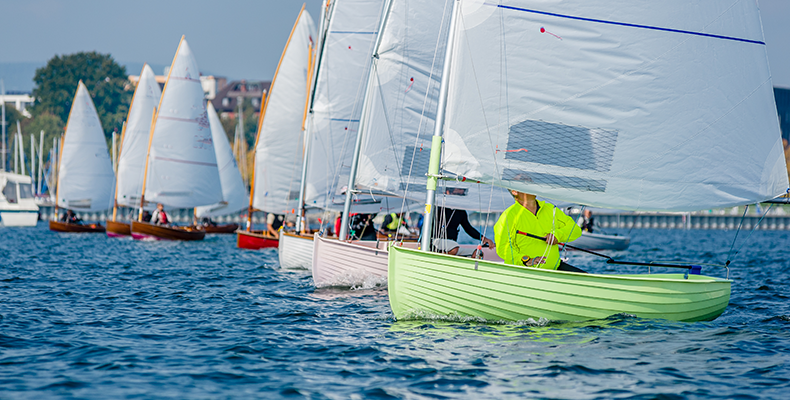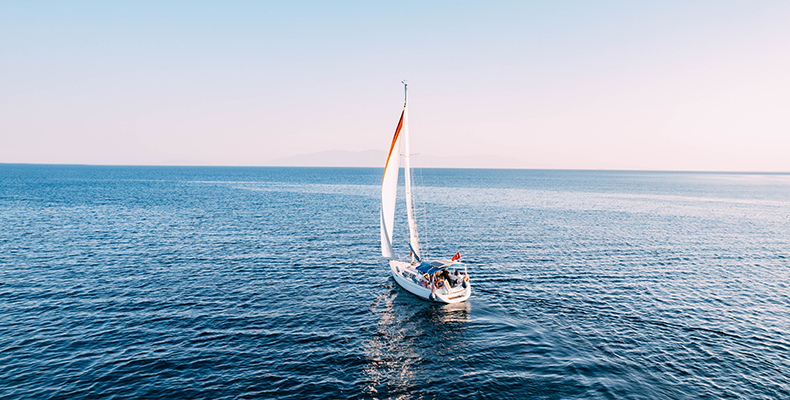Transporting a specialized sailboat differs drastically from hauling everyday powerboats. While any vessel relocation poses logistical challenges, the unique structural features central to sailing warrant special handling considerations.
Specifically, the towering mast and prominent keel protruding from the hull can complicate loading, securing, and transport if they are not adequately addressed. These defining sailboat appendages introduce additional points of vulnerability and accessibility limitations that standard hauling equipment cannot accommodate.
As leading sailboat transportation experts facilitating thousands of successful transports annually, we receive endless inquiries from sailing enthusiasts curious about how masts are lowered through tunnels or keels cleared under bridges. They also worry about protecting their boat’s most visible and valuable assets across long overland journeys.
Read on for a primer on mast and keel prep, handling, and safety from our veteran captains. We outline best practices at each step so your sailboat reaches the destination intact and is ready to hoist sails again proudly. Make sure to leave port with these essential insights!
Essential Mast Knowledge: Anatomy, Types and Role

A sailboat’s mast serves as the core backbone and pillar, upholding the extensive sail plans and rigging essential for harnessing wind power. Beyond a supportive column, the mast facilitates critical functions central to seamanship.
The mast on a contemporary sailboat acts as a sturdy foundation for attaching sails, supporting cabling, and assisting vessel control via lines and winches. Typically positioned vertically centred along the hull and extending high overhead, masts enable the modern sailing craft to utilize wind energy for propulsion by elevating canvas-catching the breeze.
Types of Masts
Sailboat masts come in different configurations and can be further categorized based on construction, rigging attachments and stepping arrangement. Common types include a single mast with stays, freestanding unstayed masts, fractionally-rigged shortcut masts, and classic schooner masts with fore and aft poles. Materials range from aluminium to carbon fiber or even wood on vintage boats.
Masts are designed and sized based on the hull type, greatly influencing sailboat performance attributes. The three primary hull classifications are:
Monohull: The most common design with a single deep hull providing interior capacity but slower speeds.
Catamarans: Twin slim hulls connected by a deck increase stability and enable higher speed potential.
Multihulls: Three, four, or five-long narrow hulls offer the most stability but pose manufacturing challenges.
The Keel: A Critical Component

A keel is a long beam of timber that runs lengthwise along the bottom of a ship from bow to stern. Its primary purpose is to provide stability and control on the boat. Some essential functions of the keel are:
Stability: The weight of the keel lowers the ship’s center of gravity, making it less likely to capsize and giving it better strength in the water. This allows the boat to sail more safely in rough seas.
Direction Control: The keel helps the ship move straight forward through the water instead of slipping sideways. It creates hydrodynamic lift and drag as water flows past it, allowing the vessel to track in a straight line.
Structural Support: The keel connects to the significant frames and ribs throughout the hull, giving the entire ship an internal “backbone” and added longitudinal strength. This allows it to handle large waves and heavy loads.
Keel Types: Flat, Bar, and Duct Variations
Flat plate keels: As the name implies, they consist of uniform thick steel plates running the hull’s length. These commonly appear in single or double-bottom designs paired with supportive longitudinal framing dubbed riders and keelsons. Flat plates sufficiently support larger ships better than primitive bar keels.
Bar keels: Bark keels include only centered steel bars or plate amidships, lacking connectivity with adjoining hull framework. These primitive versions saved early steel shipbuilding costs, but strength limitations keep modern usage limited to smaller crafts better surviving potential groundings from the lack of support.
Duct keels are popular on contemporary tankers that encapsulate pipes or access passages within a box-like watertight structure in double hulls. Built up by robust inner longitudinal girders no further than 1.83 meters apart, transverse braces provide rigidity. Spacing ensures properly supporting blocks when dry-docking.
Keel Maintenance and Safety Considerations
So, what minimal measures should captains, ship-owners, and dock managers implement on keels under their purview? Read on to find out.
Regular Inspections: The keel should be thoroughly inspected periodically for signs of corrosion, cracks, or damage.
Painting & Coatings: Regularly applying appropriate anti-fouling and anti-corrosive paints/coatings prevents rust and preserves the keel over long-term operation. Proper surface preparation is critical.
Groundings: Running aground can cause unseen keel damage, like hairline fractures. After groundings, haul-out inspections are crucial to verify the keel’s fitness.
Reinforcements & Repairs: Adding reinforced plates or frames around damaged keel areas may be needed for sufficient repair. The entire section may need replacement if damage is extreme.
Balance Considerations: Significant alterations to the keel shape can affect the ship’s balance and stability. All changes require stability testing and potentially ballast adjustments.
Safety Margins: Design safety margins for keel strength should be maintained with any repairs, corrosion allowance, modifications or reconsidered in extreme loading cases.
How a Sailboat’s Mast and Keel Achieve Dynamic Balance
Most novice sailors intuitively grasp that wind propels the boat sails forward. Yet a sailboat could never harness this raw power without the essential stability from the keel area cutting below sea level. This integral underwater foil provides critical functions:
Ballast & Stability: At around 2,000-30,000 pounds, the dense keel weight significantly lowers a sailboat’s center of gravity. This ballast effect resists the tilting force of wind and water. Adequate depth, surface area, rake angles, and careful placement achieve self-righting equilibrium so a sailboat remains upright.
Directional Control: The foil shape creates hydrodynamic resistance as water passes the keel. This allows lateral lift to counteract sideways slipping and improves tracking straight downwind. Keel fins generate lift and flow just like an aircraft wing does.
Structural Backbone: Interconnecting with interior frames provides hull and rig reinforcement overall. Together, the integrated keelson runs the length of the boat.
Pivot Point: During turns, the keel pivots, allowing smooth arcs despite the beam reaching momentum. This aids navigation through headwinds without stalling.
How the Mast Works Hand-in-Hand with the Keel
In contrast to its hidden partner, a sailboat’s mast and sails act as the visible driving “engine”, converting push from the wind into propulsion. Its essential functions include:
Harness Wind: Tall, upright masts allow large sail areas to capture passing airflow. The total sail plan should balance the overall boat size. The mast supports the rigging network and sail shape.
Generate Thrust: Based on air/fluid dynamics principles, curved sails create low-pressure “lift” on the front, with high-pressure “drag” behind. This amplifies apparent windspeed for forward impulse.
Tilting Force: Wind impacting the sail area produces a healing impulse related to the sail’s height off water. This lever-arm effect inclines sailboats laterally up to 45 degrees or more.
Steering Response: Sail trim adjustments alter the center of lateral resistance relative to the underwater foil (keel), improving directional control responsiveness.
Righting Arm: An angle of the sail profile shape helps counteract excess heeling. This “leans” an up-righting force against the tilt momentum.
Historical Quest for the Ultimate in Keel & Mast Efficiency
Across centuries of maritime tradition, sailboat engineers continue chasing the perfect ratio between driving sails aloft and essential underwater stabilizers. Design breakthroughs at times radically altered this equilibrium:
Hybrid Keel Shapes (Wing Keels): Australia II’s 1983 “winged keel” broke the America’s Cup, etc…
Modern Materials (Carbon Fiber): 21st-century masts/booms withstand extreme loads & environment but at a cost…
Hydrofoils & Apparent Wind: Harnesses underwater lift directly. Changes sailing angles and stability requirements fundamentally.
Automated Sails: Docile canvas replaced with rigid, rotating wings. Adds weight vs power tradeoffs.
Computer Modeling: Fluid-structure analysis via simulation improves aspects from hull flows to sail shape refinement that enhances efficiency from draft board to actual sailing.
Yet, for all innovations, the sailing community returns time and again to fundamental physics. Careful designs consider the dynamic interplay between underwater and above-deck components. Striking an ideal balance between the keel’s stabilizing physics and soaring mast power generates sailing magic at its best.
A Dramatic Display of Keel-Rig Integration: The 1983 America’s Cup
A fascinating study in the mast versus keel give-and-take arose during the famed 1983 America’s Cup race between defenders of the 132-year trophy, the American boat Liberty, and the Australian challenger, Australia II.
The Australian syndicate arrived with a radical new winged keel tailored to the San Diego race conditions. Designer Ben Lexcen aimed to reduce drag while providing extra low-speed stability and more effective sail power. Their short mast was geared towards catching steady ocean breezes.
Meanwhile, Liberty sported a traditional keel but an enormous lateral sail area leveraged by a towering 195-foot mast, the maximum size allowed. America was betting big on harnessing strong winds with all this acreage. But the tradeoff was trickier boat handling in choppy waves.
Liberty’s immense rig faltered in light winds while Australia II’s compact sails kept steady flow, aided by the unique keel wings generating smooth lift when it counted most. Brutal San Diego conditions later played into Liberty’s wheelhouse, but clever Australian tactics prevailed.
This remains a legendary case of innovative keel design and mast plan integration overcoming sheer sail power to achieve victory. It represented a triumph of hydrodynamic engineering working in functional synergy with onboard systems.
The Ins and Outs of Transporting Sailboats Safely
Sailboats are a joy out on the open water, but getting them to and from the dock poses unique logistical hurdles. Their prominent, protruding keels, tall masts, and lightweight hulls make trailering trickier than the average vehicle. However, transport can be smooth sailing with careful planning and protective measures. Here’s a breakdown of crucial sailboat transport challenges and prudent solutions.
Clearing Bridges, Overpasses, and Tunnels
First and foremost is planning a road route where your sailboat and trailer will physically fit under bridges, overhead signs, wires, and through tunnels. Mapping out all ground clearances along the way is essential. Measure total transport height with mast and antennas folded down and confirm it against vertical clearances. Consider bypassing particularly tight squeezes.
For exceptionally tall craft, having a licensed escort vehicle with a height pole may be mandatory to detect impending collisions with bridges. Ensure your trailer meets regulations with proper reflectors, lights, safety chains, and inspected tires. Braking performance is critical with heavy boat weight.
Protecting Vulnerable Rigging and Hardware
While underway, vibration and road shocks can hammer away at a sailboat’s delicate fittings and joints. Remove or secure loose deck items like running rigging, winch handles, canvas covers, and electronics. The stowing gear below the deck and triple-checking for any forgotten equipment prevents highway collisions.
Padding spreaders, railings, masts, and the boom with protective foam prevents abrasion damage while lashing them tightly to the frame using line or fastening straps. Cushioning the keel at trailer bunks avoids direct impact, too. It also helps to maintain slow speeds and avoid potholes or sudden braking en route.
Launch Ramp Logistics
Roads are one thing, but moving an uncommon sailboat into the water requires special ramps. Ensure the approach angle is manageable for keel clearance. Having a trailer with multiple axles and keel support rollers alleviates this. Renting a yard travel lift or using a specialized dolly cradle securely cradles the hull.
Watching currents, wind direction, and local traffic during launching avoids accidents. Have fenders, mooring lines attached, and an experienced crew ready to receive the boat. Equally important is having a marked navigable path outbound to avoid running aground. It pays dividends to test depths using a lead line sounder first slowly.
Leave It to The Experts
With all these logistical considerations for safely transporting sailboats, it often pays to let a professional handle the challenging job. Services like uShip provide access to specialized boat haulers with suitable trailers, lifts, clearance knowledge, and handling experience.
List your sailboat delivery details for transporters to bid on shipment services that remove the hassle of moving your craft. The peace of mind of using an insured pro who regularly navigates marinas, bridges, and launch ramps may be worth the cost for many sailors.
Smooth Sailing: How uShip Streamlines Sailboat Transport Logistics
Transporting a sailboat introduces obstacles like traversing bridges, stabilizing masts, and carefully launching offshore – complexities that standard vehicle haulers may not handle safely. uShip provides specialized sailboat shipping services to coordinate these unique logistical challenges from dock to destination.
uShip’s Role in Sailboat Logistics uShip is a transport marketplace matching boat owners needing delivery with carriers with suitable trailers, skills, and insurance. After entering details like sailboat size, transport route, and timing, captains receive competitive bids from trusted haulers.
Advantages include:
Specialized Equipment: Carriers have customized trailers, lifts, and accessories for delicate sailboats, plus ramp launching/retrieval experience. This avoids DIY rental logistics.
Adaptive Routing: Transporters plan optimal road routes accounting for low bridges, tunnels, and awkward marina access driveways.
Handling Expertise: Experienced crews know how to securely lash down masts, wrap vulnerable gunwales in protective padding, and distribute weight evenly. No step is missed in preparing for bumpy rides.
Door-to-Shore Coordination: Complete port-to-port shipping consolidation means sailboat captains deal with one service instead of arranging multiple carriers. uShip transporters can handle all road, waterway, and marina transit tasks.
Insurance Protection: uShip-certified carriers are licensed, bonded and insured, providing coverage that protects valuable boats and gear against mishaps that DIY towing may not cover.
Streamlined Transport for Sailboat Captains
For sailboat owners and captains, listing a shipping job on uShip removes hassles like scouring for reputable carriers, comparing vague rate quotes, and attempting perilous DIY towing. Instead, uShip services set sail smoothly thanks to bespoke pages, adaptive trip planning and complete port-to-port conveyance.
Spend more moments sailing under sunny skies rather than sweating small logistics. Let the maritime shipping experts at uShip chart the shortest point-to-point course to transport your sailboat safely and affordably!
Summing Up
Transporting sailboats introduces unique hurdles demanding customized trailers, bridge-clearing savvy, mast stabilizing know-how, and marina access experience. Attempting the job without proper equipment and handling skills risks expensive damage or capsizing incidents.
Rather than risking your sailboat’s safety by tackling complex shipping logistics solo, leverage uShip. Certified carriers with specialized gear and staff create safe passage plans accounting for each boat’s profile, route obstacles, and dock challenges. Custom transportation setups, insurance protection, expert loading assistance, and port-to-port shipping simplify sailboat delivery significantly for owners.
Save money on consumer rental trailers with the necessary keel or hull reinforcements. Avoid potential disasters trying to squeeze large sailboats under bridges yourself. Let the maritime shipping professionals take on the unique transportation intricacies on your behalf instead! Connect with specialized boat shipping services on uShip for competitive quotes that get you back on the water faster. Here’s to smooth, vista-filled sailing adventures ahead!
People Also Ask (PAA)
How Does The Mast Affect Sailboat Performance?
The mast supports the sails, allowing them to catch wind to propel the boat. Taller masts with more sail area increase speed potential but can make handling trickier.
What Is The Purpose Of The Keel In A Sailboat?
The keel resists side slippage, provides ballast for stability, aids steering, and enables smoother sailing through water flow.
What Are The Different Types Of Keels In Sailboats?
Common keel types are full-length fins, winged, bilge keels, centerboards, and multihull dagger boards. Each affects stability, drag, and maneuverability differently.
How Do You Transport A Sailboat With A Large Mast?
Use adequate clearance for the mast height when trailering. Mast sections may need separating or securing to the deck horizontally during transport.
What Are The Challenges In Sailboat Logistics?
Challenges include limited marina access, fewer specialized transportation options, and vulnerability of above-deck components during shipping.
How Does Keel Shape Impact Sailboat Stability?
A curved keel shape with more aft surface area improves directional stability. Full-length deep keels resist capsizing, while winged keels provide extra lift.
What Services Does uShip.com Offer For Sailboat Transportation?
uShip services for sailboats include consolidated port-to-port shipping, coverage and damage protection, and certified carriers with boat expertise/gear.
How To Prepare A Sailboat For Transportation?
Sailboat transport prep involves mapping clearances along the route, protecting hardware, lashing down masts, and planning launch support.



